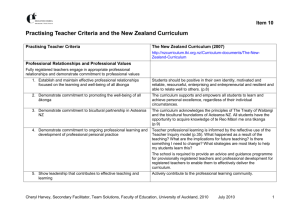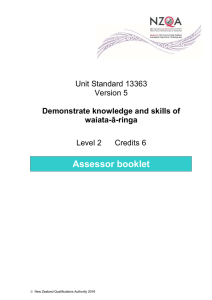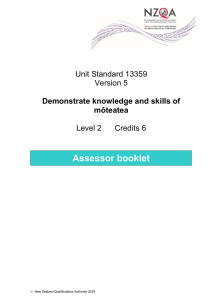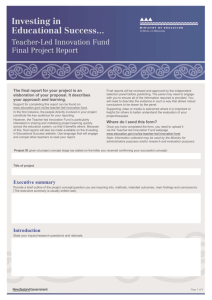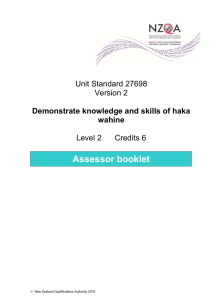Assessment Guide (DOCX, 327KB)
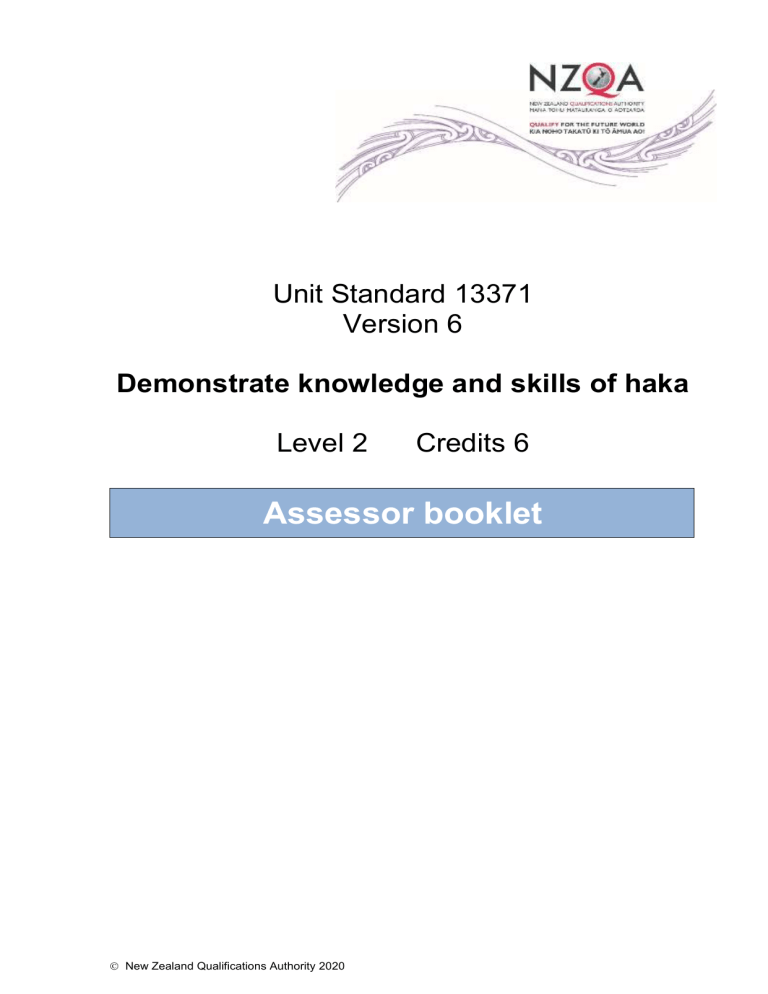
Unit Standard 13371
Version 6
Demonstrate knowledge and skills of haka
Level 2 Credits 6
Assessor booklet
New Zealand Qualifications Authority 2020
Unit Standard 13371 Version 5 – Demonstrate knowledge and skills of haka
Level 2 Credit 6
Assessor information
This unit standard can be awarded with Paetae/Achievement, Kaiaka/Merit and
Kairangi/Excellence grades.
Assessment criteria
Paetae/Achievement Achievement with
Kaiaka/Merit
Achievement with
Kairangi/Excellence
Demonstrate knowledge of haka, and the essential skills of haka.
Demonstrate in-depth knowledge of haka, and the essential skills of haka with purpose.
New Zealand Qualifications Authority 2020
Demonstrate comprehensive knowledge of haka, and the essential skills of haka with artistic expression.
There are THREE (3) assessment tasks that the ākonga must correctly complete to gain credits for this standard. Once the ākonga has correctly completed the tasks, the assessor must complete the assessment schedule for each ākonga.
Please remember that the focus is Māori performance!
Nō reira:
the most effective activities for assessment will be those that are practical or performance based
written tests should be discouraged
assessments can occur in a range of contexts, e.g. marae, school, classroom, practices or other learning contexts
kapa haka competitions can be used to assess Outcome 2 of this unit standard
local haka exponents and/or experts may be used to assess ākonga.
Ākonga assessment booklet
The ākonga receives this. It outlines important information for the ākonga including:
assessment and other information
assessment tasks.
Ākonga assessment task sheets
These sheets and any other evidence should be collected by the Assessor and retained for assessment and moderation purposes.
Where ākonga choose to provide oral description/evidence for Task 1 and/or Task 2
(Outcome 1), this must be recorded. Where ākonga work has been selected for moderation, the recorded evidence must be included with the materials.
You will need to discuss with the ākonga the length of time they have to complete the assessment. He ture-akōnui
: one credit equates to 10 notional hours of teaching and assessment.
Page 2 of 11
Unit Standard 13371 Version 6 – Demonstrate knowledge and skills of haka
Level 2 Credits 6
Evidence of Task 3 (Outcome 2) must be recorded. Where ākonga work has been selected for moderation, the recorded material must be included with the materials.
Where recorded evidence is submitted for moderation, the ākonga identification sheet (refer following link): http://www.nzqa.govt.nz/qualificationsstandards/qualifications/ncea/subjects/preparing-digital-visual-submissions-formoderation/ must be included.
Authenticity
As per NZQA requirements:
you must verify that the work submitted for assessment has been produced by the ākonga.
you must consider (and manage) the potential for work to have been copied, borrowed from another ākonga, photocopied from a book or downloaded from the internet.
It is okay for ākonga to work with and learn from others to gather information from a variety of sources. However, you must be clear that the work to be assessed has been processed and produced by the ākonga.
To help manage authenticity of ākonga work, where the ākonga is asked to complete any written tasks, the ākonga is asked to use their own words as well as provide reference/s for their information.
Please ensure you discuss this with your ākonga.
For further information, please refer to the following link: http://www.nzqa.govt.nz/providers-partners/assessment-and-moderation/assessmentof-standards/generic-resources/authenticity/
Referencing
This assessment requires the ākonga the reference his/her information. For the purposes of this assessment, the following are examples of reference styles.
However, you may want to change the style.
Examples of referencing:
Book: Author last name, Initial. (Year book was published), Name of Book ,
Publication City, Country: Publisher. e.g.
Pōtiki, M. (1995) Haka Mana Para Tawa Ngāwhā.
Kaitaia, New
Zealand: Kauae Runga Publishers.
Webpages: reference the homepage . e.g. http://www.hakamanaparatawangawha.co.nz
Course hand out/Lecture notes:
Lecturer/Teacher last name, Initial. (Year of course/lecture). Course title : [PowerPoint Slides]/[Video]/[Lecture notes]. City, Country: Venue. e.g.
Page 3 of 11
New Zealand Qualifications Authority 2020
Unit Standard 13371 Version 6 – Demonstrate knowledge and skills of haka
Level 2 Credits 6
Knowles, B. (2012). MPA class : [Te Wakahuia Video]. Piopiotahi, New
Zealand: Piopiotahi College.
Preparation for moderation
Form
Attached for moderation*
1 Moderation cover sheet. This should include the ākonga identifier and grades.
Secondary refer following link: http://www.nzqa.govt.nz/assets/Providers-and-partners/Assessmentand-moderation/sec-mod-cvrsheet-random.doc
Tertiary refer following link: http://www.nzqa.govt.nz/assets/Providers-and-partners/Assessmentand-moderation/Tertiary-Moderation/Tertiary-moderation-coversheet.doc
2 Copy of unit standard. Please ensure the version of the standard reflects the version used in the assessment task.
3 Blank copy of assessment task and assessment schedule.
4
Copy of ākonga samples (completed assessment tasks).
Standards with Kaiaka/Merit and Kairangi/Excellent grades, submit EIGHT samples of ākonga work.
5 Visual/digital evidence cover sheet: http://www.nzqa.govt.nz/assets/Providers-and-partners/Assessmentand-moderation/mod-visevidence-cvr.doc
Please remember: you cannot send Blueray discs, Hi8, DV or
MiniDV tapes, or HD files for moderation. Remember to test the recording device to ensure that it can be read in another device.
Please refer following link for further information: http://www.nzqa.govt.nz/qualificationsstandards/qualifications/ncea/subjects/preparing-digital-visualsubmissions-for-moderation/
TIP: You should start preparing the materials for moderation at least one month before the submission date. This will give you time to locate all the relevant and necessary forms and sheets.
If you have any issues with preparing materials for moderation OR do not have materials to submit (i.e. you didn’t assess this standard), SPEAK to your Principal
Nominee (PN) or Moderation Liaison (ML).
Page 4 of 11
New Zealand Qualifications Authority 2020
Unit Standard 13371 Version 6 – Demonstrate knowledge and skills of haka
Level 2 Credits 6
Assessor information – assessment tasks
Outcome 1 Demonstrate knowledge of haka
Assessment Task 1
– Categories
Describe/explain THREE different categories of haka.
The categories of haka are – kaioraora, manawa wera, ngeri, peruperu, pōkeka, taparahi, tūtū ngārahu, whakatū waewae
The information must be in ākonga’s own words and references must be provided.
This task assesses the evidence requirements of 1.1.
1.1 Haka are described in terms of their categories.
Sample answer that would be acceptable ‘Kaiaka/Merit’.
1 Tūtū ngārahu Tūtū ngārahu
were traditionally performed before going into battle to invoke Tūmatauenga (god of war), and warn the enemy of the fate awaiting him (or her).
Not only is the tūtū ngārahu
noted for being a haka performed with weapons, but also for its up and down jumps ( pēpeke or whakapēpeke ), which the kapa haka would do in unison. Traditionally, they were done (usually prior to the war party leaving for battle) in front of kaumātua and experienced warriors, who judged by the performance whether the ope tauā (or individuals) were ready to go into battle. Sometimes, however, tutu ngārahu were performed on the battlefield, to show the enemy one’s preparedness for battle.
Also called ngārahu, tū ngārahu, tūtū ngārehu, tūtū waewae, and whakarewarewa – the tūtū ngārahu was not a haka of the whare tapere .
N gā mihi ki te ipurangi: http://www.maoridictionary.co.nz/word/8831 .
NB: your ākonga has been asked to provide references. Where you have referred to a book, or website, or person, please acknowledge this in your lessons.
Page 5 of 11
New Zealand Qualifications Authority 2020
Unit Standard 13371 Version 6 – Demonstrate knowledge and skills of haka
Level 2 Credits 6
Assessment Task 2 – Tikanga and pūtake
Describe/explain the tikanga and pūtake for TWO haka, each from different categories.
The categories of haka are - kaioraora, manawa wera, ngeri, peruperu, pōkeka, taparahi, tūtū ngārahu, whakatū waewae.
The information must be in the ākonga’s own words and references must be provided.
This task assesses the evidence requirements of 1.2.
1.2 Haka are described in terms of tikanga and pūtake.
Sample answer that would be acceptable for ‘Kaiaka/Merit’.
1 Ngeri Ka Mate – Te Rauparaha (1760-1849)
“ Ka mate ” is a ngeri , the lyrics of which were composed by Te
Rauparaha, a chief of Ngāti Toa Rangatira. It was written sometime between the 1760s and 1849.
During conflict with Waikato and Ngāti Maniapoto, Te
Rauparaha travelled from Kāwhia to seek alliances with other iwi, including Ngāti Tūwharetoa. At Te Rapa, he was told by
Te Heuheu that he was being pursued by a war party seeking revenge. Te Heuheu directed Te Rauparaha to seek the protection of Te Wharerangi.
Te Wharerangi instructed Te Rauparaha to climb into a kūmara pit and for his wife (Te Rangikoaea) to sit on top. By combining the spiritual qualities of a woman ( mana wahine ) and of food ( noa ), Te Wharerangi was able to weaken the power of the karakia from the tohunga guiding the war party to him.
As he hid in the pit Te Rauparaha wondered whether he would survive the ordeal, or die. It was during this time that he muttered “
Ka mate! Ka mate!
” under his breath (Will I die!), and “ Ka ora! Ka ora!
” (Or will I live!). Te Wharerangi eventually convinced Ngāti Te Aho that Te Rauparaha had escaped. It was then that Te Rauparaha finally exclaimed
“
Ka ora! Ka ora! Tēnei te tangata pūhuruhuru, nāna i tiki mai whakawhiti te rā!
” (I live! I live! For it was the power of a woman that fetched the sun and caused it to shine again!)
Page 6 of 11
New Zealand Qualifications Authority 2020
Unit Standard 13371 Version 6 – Demonstrate knowledge and skills of haka
Level 2 Credits 6
N gā mihi ki te ipurangi: http://www.ngatitoa.iwi.nz/ka-mate/
NB: your ākonga has been asked to provide references. Where you have referred to a book, or website, or person, please acknowledge this in your lessons.
Outcome 2 Demonstrate the essential skills of haka
Assessment Task 3
– Demonstration
Perform TWO haka items, each from different categories.
The categories of haka are - kaioraora, manawa wera, ngeri, peruperu, pōkeka, taparahi, tūtū ngārahu, whakatū waewae.
This task assesses the evidence requirements of 2.1.
2.1 Appropriate body movement and voice, and correct pronunciation are demonstrated in accordance with iwi tradition, and/or the pūtake of the haka.
I te ākonga e haka ana: mō Paetae/Achieved , me:
matatau ia ki ngā kupu
tika te mita o tōna reo, tōna whakahua i ngā kupu, me tōna hā
tika tōna whai i te rangi
hāngai tōna tū, me te kori i tōna tinana/mahi-ā-ringa, ki te/ngā tikanga me te pūtake o te haka. mō
Kaiaka/Merit , me:
mau ki te tangi me te wairua o te rangi
hāngai te kori o tōna tinana ki te wairua me ngā kupu o te haka, ā, kia tika tōna tū. mō Kairangi/Excellence , me:
tika te whakaputa i te wairua o te rangi, mai i te tīmatanga ki te whakamutunga
tika te whakaputa i te wairua o tōna tinana me ngā kupu o te haka, mai i te tīmatanga ki te whakamutunga
Tērā ētahi wā, ka hapa te ākonga.
A checklist for this task has been provided for you on the following page. This may help when you complete the assessment schedule. Please ensure one checklist is used per haka. You will need to photocopy extra copies of the checklist.
Page 7 of 11
New Zealand Qualifications Authority 2020
Unit Standard 13371 Version 6 – Demonstrate knowledge and skills of haka
Level 2 Credits 6
Outcome 2 – Assessor checklist: Ākonga performance
Ākonga Haka item
Date
Requirements
Category (please tick) kaioraora manawa wera ngeri peruperu pōkeka taparahi tūtū ngārahu whakatū waewae
Haka is performed.
Performance criteria
Tick relevant box.
Kua matatau ki ngā kupu.
Kua tika te mita o te reo, te whakahua i ngā kupu, me te hā.
Kua tika te whai i te rangi.
Kua hāngai te tū, me te kori i te tinana/mahiā-ringa ki te/ngā tikanga me te pūtake o te haka.
Paetae/Achieved
Kua mau ki te tangi me te wairua o te rangi.
Kua hāngai te kori o te tinana ki te wairua me ngā kupu o te haka, ā, kia tika te tū.
Kaiaka/Merit
Kua tika te whakaputa i te wairua o te rangi, mai i te tīmatanga ki te whakamutunga.
Kua tika te whakaputa i te wairua o te tinana me ngā kupu o te haka, mai i te tīmatanga ki te whakamutunga.
Kairangi/Excellence
Tutor comments
Page 8 of 11
New Zealand Qualifications Authority 2020
Unit Standard 13371 Version 6 – Demonstrate knowledge and skills of haka
Level 2 Credits 6
Assessment Schedule
Task 1 –Describe/explain THREE different categories of haka.
Evidence for Paetae/Achievement
It is expected that ākonga samples will vary, according to iwi traditions. However, the following components should be included in the ākonga responses:
the choice of words
the use of language devices to convey specific purposes and
composition style is specific to the category of haka
Evidence for Achievement with
Kaiaka/Merit
As per Paetae/Achievement, plus:
has identified composers from different haka categories.
Evidence for Achievement with
Kairangi/Excellence
As per Kaiaka/Merit, plus:
has linked meaning of and reasons for different haka categories.
Grade
M
E
A
Please tick:
N
Judgement for Paetae/Achieved Judgement for Kaiaka/Merit
THREE haka categories are correctly described/explained.
Haka are from different categories.
Reference/s is/are provided.
Judgement for Kairangi/Excellence
.
Examples of referencing:
Book : Pōtiki, M. (1995) Haka Mana Para Tawa Ngāwhā.
Kaitaia, New Zealand: Kauae Runga Publishers.
Webpage: http://www.hakamanaparatawangawha.co.nz
Course hand out/Lecture notes: Knowles, B. (2012). MPA class : [Te Wakahuia Video]. Piopiotahi, New Zealand: Piopiotahi College
Page 9 of 11
New Zealand Qualifications Authority 2020
Unit Standard 13371 Version 6 – Demonstrate knowledge and skills of haka
Level 2 Credits 6
Task 2 – Describe/explain the tikanga and pūtake for TWO haka, each from different categories.
Evidence for Paetae/Achievement Evidence for Achievement with Kaiaka/Merit Evidence for Achievement with
Kairangi/Excellence
It is expected that ākonga samples will vary, according to iwi traditions. However, the following components should be included in the ākonga responses:
the category matches the haka
the name of the composer is identified, and his/her iwi is/are identified
the name of the haka is identified
when and why the haka was composed
the words and translation of the haka
values, and Māori world view.
Judgement for Paetae/Achieved
As per Paetae/Achievement, plus:
has identified the background kōrero to the composition of each haka.
As per Kaiaka/Merit, plus:
has identified any personal (to the composer), social, or historical influences that led to the development of the haka composition.
Judgement for Kaiaka/Merit Judgement for Kairangi/Excellence
Tikanga and pūtake of TWO haka are correctly described/explained
The haka are each from different categories.
Reference/s is/are provided.
Examples of referencing :
Book : Pōtiki, M. (1995) Haka Mana Para Tawa Ngāwhā.
Kaitaia, New Zealand: Kauae Runga Publishers.
Webpage: http://www.hakamanaparatawangawha.co.nz
Course hand out/Lecture notes: Knowles, B. (2012). MPA class : [Te Wakahuia Video]. Piopiotahi, New Zealand: Piopiotahi College
Grade
A
Please tick:
N
M
E
Page 10 of 11
New Zealand Qualifications Authority 2020
Unit Standard 13371 Version 6 – Demonstrate knowledge and skills of haka
Level 2 Credits 6
Task 3 – Perform TWO haka items, each from different categories.
Evidence for Paetae/Achievement Evidence for Achievement with Kaiaka/Merit Evidence for Achievement with
Kairangi/Excellence
Ka whakaatu te ākonga:
kua matatau ki ngā kupu
kua tika te mita o te reo, te whakahua i ngā kupu me te hā
kua tika te whai i te rangi kua hāngai te tū, me te kori i te tinana/mahiā-ringa ki te/ngā tikanga me te pūtake o te haka.
Judgement for Paetae/Achieved
As per Paetae/Achieved, plus:
kua mau ki te tangi me te wairua o te rangi
kua hāngai te kori o te tinana ki te wairua me ngā kupu o te haka, ā, kia tika te tū.
Judgement for Kaiaka/Merit
As per Kaiaka/Merit, plus:
kua tika te whakaputa i te wairua o te rangi, mai i te tīmatanga ki te whakamutunga
kua tika te whakaputa i te wairua o te tinana me ngā kupu o te haka, mai i te tīmatanga ki te whakamutunga.
Judgement for Kairangi/Excellence
TWO haka are performed
Haka are each from different categories
Pronunciation is correct
Pūtake is in accordance with iwi tradition.
Voice and body movement is appropriate.
Grade
M
A
E
Please tick:
N
Overall grade (please circle) N (Not Achieved) A (Paetae/Achieved) M (Kaiaka/Merit) E (Kairangi/Excellence)
Ākonga name
Assessor Name
Ākonga signature Assessor signature
Completion date
Page 11 of 11
New Zealand Qualifications Authority 2020


